TANDBERG TT1260 DIRBAS Reference guide
- Category
- Video switches
- Type
- Reference guide
This manual is also suitable for

ST.RE.E10100.1
Issue 1
ENGLISH (UK)
REFERENCE GUIDE
TT1260 Contribution Receiver
TT1260/DIRBAS, TT1260/CIBAS[/48]
and Options
Software Version 4.0.0 (and later)
TT1260 Contribution Receiver

Preliminary Pages
Page ii Reference Guide: TT1260 Contribution Receiver
ST.RE.E10100.1
Issue 1 first published in 2004 by:
T
ANDBERG TELEVISION LTD
REGISTERED ADDRESS:
U
NIT 2 STRATEGIC PARK, COMINES WAY,
H
EDGE END, SOUTHAMPTON,
H
AMPSHIRE,
SO30 4DA
U
NITED KINGDOM
Re
g
istered Com
p
an
y
Number 03695535
This document and the information contained in it is the property o
f
TANDBERG Television Ltd and may be the subject of patents
pending and granted. It must not be used for commercial purposes
nor copied, disclosed, reproduced, stored in a retrieval system or
transmitted in any form or by any means (electronic, mechanical,
photocopying, recording or otherwise), whether in whole or in part,
without TANDBERG Television’s prior written agreement.
Ó 2004 TANDBERG Television Ltd. All rights reserved.
SVENSKA
LÄS DETTA FÖRST!
Om Ni inte förstår informationen i denna handbok
ARBETA DÅ INTE MED DENNA UTRUSTNING.
En översättning till detta språk av denna handbok kan också anskaffas, på
Er bekostnad.
ENGLISH (UK)
READ THIS FIRST!
If you do not understand the contents of this manual
DO NOT OPERATE THIS EQUIPMENT.
Also, translation into any EC official language of this manual can be made
available, at your cost.
ΕΛΛΗΝΙΚΑ
ÄΙΑΒΑΣΤΕ ΠΡÙΤΑ ΑΥΤΟ!
Αν δεν καταλÜβετε το περιεχüìενο αυτοý του βοηθÞìατοò/εγχειριδßου
ΜΗΝ ΛΕΙΤΟΥΡΓΗΣΕΤΕ ΑΥΤΟΝ ΤΟΝ ΕΞΟΠΛΙΣΜΟ.
Επßσηò, αυτü το εγχειρßδιο εßναι διαθÝσιìο σε ìετÜφραση
σε αυτÞ τη γλþσσα και ìπορεßτε να το αγορÜσετε.
DEUTSCH
LESEN SIE ZUERST DIESEN HINWEIS!
Sollte Ihnen der Inhalf dieses Handbuches nicht klar verständlich sein,
dann
BEDIENEN SIE DIESE GERÄTE NICHT!
Eine Übersetzung des Handbuches in diese Sprache ist gegen
Berechnung lieferbar.
ESPAÑOL
LEA ESTE AVISO PRIMERO!
Si no entiende el contenido de este manual
NO OPERE ESTE EQUIPO.
Podemos asimismo suministrarle una traducción de este manual al
(idioma) previo pago de una cantidad adicional que deberá abonar usted
mismo.
FRANÇAIS
AVANT TOUT, LISEZ CE QUI SUIT!
Si vous ne comprenez pas les instructions contenues dans ce manuel
NE FAITES PAS FONCTIONNER CET APPAREIL.
En outre, nous pouvons vous proposer, à vos frais, une version française
de ce manuel.
ITALIANO
LEGGERE QUESTO AVVISO PER PRIMO!
Se non si capisce il contenuto del presente manuale
NON UTILIZZARE L’APPARECCHIATURA.
È anche disponibile la versione italiana di questo manuale, ma il costo è a
carico dell’utente.
PORTUGUÊS
LEIA O TEXTO ABAIXO ANTES DE MAIS NADA!
Se não compreende o texto deste manual
NÃO UTILIZE O EQUIPAMENTO.
O utilizador poderá também obter uma tradução do manual para o
português à própria custa.
NEDERLANDS
LEES DIT EERST!
Als u de inhoud van deze handleiding niet begrijpt
STEL DEZE APPARATUUR DAN NIET IN WERKING.
U kunt tevens, op eigen kosten, een vertaling van deze handleiding
krijgen.
DANSK
LÆS DETTE FØRST!
Udstyret må ikke betjenes
MEDMINDRE DE TIL FULDE FORSTÅR INDHOLDET AF DENNE
HÅNDBOG.
Vi kan også for Deres regning levere en dansk oversættelse af denne
håndbog.
SUOMI
LUE ENNEN KÄYTTÖÄ!
Jos et ymmärrä käsikirjan sisältöä
ÄLÄ KÄYTÄ LAITETTA.
Käsikirja voidaan myös suomentaa asiakkaan kustannuksella.

Preliminary Pages
Reference Guide: TT1260 Contribution Receiver Page iii
ST.RE.E10100.1
List of Contents
Chapter 1: Introduction
This chapter identifies the equipment versions covered by this manual;
describes the purpose of the equipment in a typical system; provides a
summary of its main features; identifies the controls, indicators and
connectors.
Chapter 2: Installing the Equipment
This chapter provides a guide to the suitability of an installation; gives
detailed procedures for the preparation, installation and configuration of
the equipment including important safety information; provides pin-out
details of the external connectors; and details the power-up/-down
procedures.
Chapter 3: Operating the Equipment Locally
This chapter provides a guide to using the Front Panel LCD interface and
details the setting-up, configuration and operating procedures.
Chapter 4: Operating the Equipment Remotely
This chapter provides a guide to configuring and preparing the unit for
remote operation.
Chapter 5: Alarms
This chapter provides a guide to configuring the alarm interface.
Chapter 6: Options
This chapter describes the available hardware and software options for the
IRD.
Chapter 7: Preventive Maintenance and Fault-finding
This chapter details routine maintenance tasks to be performed; provides
general servicing advice, and information regarding warranty and
maintenance; provides general fault-finding information for other types of
problem which may be encountered.
Annex A: Glossary
Annex B: Technical Specification
Annex C: Menus
Annex D: Language Abbreviations
Annex E: Using the TT1260 with the TANDBERG Director
System
Annex F: Factory Defaults

Preliminary Pages
Page iv Reference Guide: TT1260 Contribution Receiver
ST.RE.E10100.1
About This Reference Guide
This Reference Guide provides instructions and information for the
installation and operation of the TT1260 Contribution Receiver and
Options.
This Reference Guide should be kept in a safe place for reference for the
life of the equipment. It is not intended that this Reference Guide will be
amended by the issue of individual pages. Any revision will be by a
complete reissue. Further copies of this Reference Guide can be ordered
from the address shown on page vii. If passing the equipment to a third
party, also pass the relevant documentation.
Information about this equipment was originally published as an
Instruction Manual under the number ST.TM.E10100. Issues of that
manual are listed below:
Issue Date Software Version Comments
1 March 2002 2.1 Initial release.
2 May 2002 2.1 Changes to Annex B Technical Specification, Chapter 4 added.
3 July 2002 2.2 DVB Common Interface, COFDM Demodulation, 4:2:0 Video Only
Option.
4 Dec 2003 2.2 – 3.0 TTV G.703 Interface, SNMP Control, High Speed Data over Ethernet.
Since June 2004, information has been published in the form of a User
Guide and Reference Guide. Issues of the Reference Guide (ST.RE.E10100)
are listed below:
Issue Date Software Version Comments
1 June 2004 4.0.0
The following documents are also associated with this equipment:
· ST.US.E10100: User Guide
General
All best endeavours have been made to acknowledge registered
trademarks and trademarks used throughout this manual. Any notified
omissions will be rectified in the next issue of this manual. Some
trademarks may be registered in some jurisdictions but not in others.
Registered trademarks and trademarks used are acknowledged below and
marked with their respective symbols. However, they are not marked
within the text of this manual.
Registered Trademarks
Ethernet
®
is a registered trademark of Xerox Corporation.
VideoGuard
®
is a registered trademark of NDS Limited.
Dolby Digital
®
and AC-3
®
are registered trademarks of Dolby Laboratories
Licensing Corporation
.
Trademarks
Alteia
™
is a trademark of TANDBERG Television Limited.

Preliminary Pages
Reference Guide: TT1260 Contribution Receiver Page v
ST.RE.E10100.1
Warnings, Cautions and Notes
Heed Warnings
All warnings on the product and in the operating instructions should be
adhered to. The manufacturer can not be held responsible for injuries or
damage where warnings and cautions have been ignored or taken lightly.
Read Instructions
All the safety and operating instructions should be read before this product
is operated.
Follow Instructions
All operating and use instructions should be followed.
Retain Instructions
The safety and operating instructions should be retained for future
reference.
WARNINGS...
WARNINGS GIVE INFORMATION WHICH, IF STRICTLY OBSERVED, WILL PREVENT PERSONAL
INJURY OR DEATH, OR DAMAGE TO PERSONAL PROPERTY OR THE ENVIRONMENT. THEY
ARE BOXED AND SHADED FOR EMPHASIS, AS IN THIS EXAMPLE, AND ARE PLACED
IMMEDIATELY PRECEDING THE POINT AT WHICH THE READER REQUIRES THEM.
CAUTIONS...
Cautions give information which, if strictly followed, will prevent damage to equipment or other goods.
They are boxed for emphasis, as in this example, and are placed immediately preceding the point at
which the reader requires them.
NOTES...
Notes provide supplementary information. They are highlighted for emphasis, as in this example, and
are placed immediately after the relevant text.
EMC Compliance
This equipment is certified to the EMC requirements detailed in Annex B,
Technical Specification. To maintain this certification, only use the leads
supplied or, if in doubt, contact Customer Services.

Preliminary Pages
Page vi Reference Guide: TT1260 Contribution Receiver
ST.RE.E10100.1
Contact Information
TANDBERG Television Customer Services
Support Services
Our primary objective is to provide first class customer care that is tailored
to your specific business and operational requirements. All levels are
supported by one or more service performance reviews to ensure the
perfect partnership between TANDBERG Television and your business.
Warranty
All TANDBERG Products and Systems are designed and built to the highest
standards and are covered under a comprehensive 12 month warranty.
Levels of Continuing TANDBERG Television Service Support
For stand-alone equipment, then TANDBERG Television
BASIC Advantage is the value for money choice for you. BASIC provides
you with year-by-year Service long after the warranty has expired.
For systems support you can choose either Gold or Silver Advantage.
These packages are designed to save you costs and protect your income
through enlisting the help of TANDBERG Television support specialists.
VOYAGER Advantage is the truly mobile service solution. This provides a
package specifically designed to keep you mobile and operational.
Call TANDBERG Sales for more details.
Where to Find Us
Europe, Middle East +44 (0) 23 8048 4455
and Africa: Fax: +44 (0) 23 8048 4467
Americas: +1 (321) 308 0470
fieldservice-ameri[email protected]
China: +86 10 6856 0260 (Beijing)
+852 2530 3215 (Hong Kong)
Australia/NZ: +612 9360 2053
Internet Address: http://www.tandbergtv.com

Preliminary Pages
Reference Guide: TT1260 Contribution Receiver Page vii
ST.RE.E10100.1
Technical Training
Training Courses
TANDBERG Television provides a wide range of training courses on the
operation and maintenance of our products and on their supporting
technologies. TANDBERG can provide both regularly scheduled courses and
training tailored to individual needs. Courses can be run either at your
premises or at one of our dedicated training facilities.
Where to Find Us
For further information on TANDBERG Television's training programme
please contact us:
International Telephone: +44 23 8048 4229
International Facsimile +44 23 8048 4467
E-mail Address: [email protected]
Internet Address http://www.tandbergtv.com
Customer Services and Technical Training Postal Address
Tandberg Television
Unit 2
Strategic Park
Comines Way
Hedge End
Southampton
Hampshire
SO30 4DA
United Kingdom
Return of Equipment
If you need to return equipment for repair, please contact the Customer
Services Helpdesk on +44 (0) 23 8048 4455. A Returns Authorisation
Number (RAN) will be issued and full details of the unit will be logged.
Technical Publications
If you need to contact TANDBERG Television Technical Publications
regarding this publication, e-mail: [email protected].

Preliminary Pages
Page viii Reference Guide: TT1260 Contribution Receiver
ST.RE.E10100.1
BLANK

Reference Guide: TT1260 Contribution Receiver Page 1-1
ST.RE.E10100.1
Chapter 1
1. 1Introduction
Contents
1.1 Scope of This Reference Guide................................ 1-3
1.1.1 Who Should Use This Reference Guide....... 1-3
1.1.2 What Equipment is Covered by This
Reference Guide........................................... 1-3
The Equipment Models................................. 1-3
Software Version .......................................... 1-3
1.2 Summary of Features................................................ 1-4
1.2.1 Main Features............................................... 1-4
1.2.2 Inputs............................................................ 1-6
ASI Inputs (Decoder) [Option]....................... 1-6
QPSK L-Band Inputs (Satellite Receivers)
[Option] ......................................................... 1-6
Higher Order Modulation Inputs (Satellite
Receivers) [Option]....................................... 1-6
COFDM Input (Terrestrial Receivers)
[Option] ......................................................... 1-6
TANDBERGTV G.703 Input (Telco
Receivers) [Option]....................................... 1-6
ATM AAL-1 DS3 Input (Telco Receivers)
[Option] ......................................................... 1-6
ATM AAL-1 E3 Input (Telco Receivers)
[Option] ......................................................... 1-6
IP Input [Option]............................................ 1-6
Remote Control............................................. 1-7
Frame Synchronisation................................. 1-7
1.2.3 Outputs ......................................................... 1-7
Transport Stream Outputs ............................ 1-7
Video Outputs............................................... 1-7
Audio Outputs............................................... 1-7
Data Output .................................................. 1-7
Alarm Output................................................. 1-7
1.2.4 Conditional Access and Scrambling ............. 1-8
1.3 The Satellite Receiver ...............................................1-8
1.3.1 Typical Satellite System ................................1-8
1.3.2 Input Connections .........................................1-8
1.3.3 What the Satellite Receiver Does .................1-9
1.3.4 Over-air Software Download
(TANDBERG Director Systems)..................1-10
1.4 The Telco Receiver/Decoder...................................1-11
1.4.1 Typical Decoder System .............................1-11
1.4.2 Input Connections .......................................1-11
1.4.3 What the Decoder Does..............................1-12
1.5 TT1260 Control Modes............................................1-12
1.5.1 Introduction .................................................1-12
1.5.2 Front Panel (Local) Modes..........................1-13
1.5.3 Remote Control Modes ...............................1-13
RS-232/RS-485 Port ...................................1-13
Network.......................................................1-13
1.5.4 TANDBERG Director NCP Control Mode....1-13
1.6 Guided Tour.............................................................1-14
1.6.1 Construction ................................................1-14
1.6.2 Front Panel Controls ...................................1-14
1.6.3 Front Panel LEDs........................................1-14
1.6.4 Bit Error Ratio Measurement.......................1-14
1.6.5 Conditional Access and Scrambling
Options........................................................1-15
TANDBERG Director...................................1-15
Remote Authorisation System (RAS 1
and 2)..........................................................1-15
Basic Interoperable Scrambling System
(BISS)..........................................................1-15
Signal Protection.........................................1-15
DVB Common Interface ..............................1-15

Introduction
Page 1-2 Reference Guide: TT1260 Contribution Receiver
ST.RE.E10100.1
1.6.6 Rear Panel ..................................................1-15
List of Figures
Figure 1.1: Front View of the TT1260.............................................1-3
Figure 1.2: Typical Satellite Compression System.........................1-9
Figure 1.3: What the Satellite Receiver Does ..............................1-10
Figure 1.4: Typical Download Transmission System ...................1-10
Figure 1.5: Typical Compression System.....................................1-11
Figure 1.6: Role of the Decoder ...................................................1-12
Figure 1.7: Front Panel States......................................................1-13
Figure 1.8: Front Panel Controls ..................................................1-14
Figure 1.9: TT1260 Decoder Rear Panel .....................................1-15
List of Tables
Table 1.1: Equipment Model Descriptions..................................... 1-3

Introduction
Reference Guide: TT1260 Contribution Receiver Page 1-3
ST.RE.E10100.1
1.1 Scope of This Reference Guide
1.1.1 Who Should Use This Reference Guide
This Reference Guide is written for operators/users of variants of the
TT1260 Contribution Receiver and options. It describes the unit’s functions
and operation. The Reference Guide is written to assist in the installation
and day-to-day care and operation of the unit. Maintenance information
requiring the covers to be removed is not included.
WARNING…
DO NOT REMOVE THE COVERS OF THIS EQUIPMENT. HAZARDOUS VOLTAGES ARE PRESENT
WITHIN THIS EQUIPMENT AND MAY BE EXPOSED IF THE COVERS ARE REMOVED. ONLY
TANDBERG TELEVISION TRAINED AND APPROVED SERVICE ENGINEERS ARE PERMITTED TO
SERVICE THIS EQUIPMENT.
CAUTION…
Unauthorised maintenance or the use of non-approved replacements may affect the equipment
specification and invalidate any warranties.
1.1.2 What Equipment is Covered by This Reference Guide
The Equipment Models
The IRD described in this Reference Guide is the base model.
Figure 1.1: Front View of the TT1260
Table 1.1: Equipment Model Descriptions
Model Number Marketing Code Description
Basic TT1260 with Common
Interface hardware
TT1260/CIBAS MPEG-2 SD Decoder with integrated Common Interface CAM
reader, AC mains voltage input. MPEG 4:2:0 video decode only.
Basic TT1260 with Common
Interface hardware
(-48 Vdc version)
TT1260/CIBAS/48 MPEG-2 SD Decoder with integrated Common Interface CAM
reader,
-48 Vdc voltage input. MPEG 4:2:0 video decode only.
Basic TT1260 with Director
hardware
TT1260/DIRBAS MPEG-2 SD Decoder with integrated Director Smart Card Reader,
AC mains voltage input. MPEG 4:2:0 video decode only.
Software Version
This Reference Guide covers the functions of software version 4.0.0 and
later.
To verify the installed version access the Systems Menu (Menu 6.2). The
menus are described in Annex C, Menus.

Introduction
Page 1-4 Reference Guide: TT1260 Contribution Receiver
ST.RE.E10100.1
1.2 Summary of Features
1.2.1 Main Features
The TT1260 is fully compliant with the appropriate sections of the
MPEG-2
1
, DVB-S
2
and DSNG
3
specifications and offers the following
features:
· Front Panel Controls and Indications:
² A vertical split two line x 40 character back-lit dot matrix LCD
display with pushbuttons for Up, Down, Left, Right, Edit, and Save
to provide information and operator choice entry
² LEDs to indicate lock and general alarm conditions
· Service Selection:
² Chosen from a menu list of available services carried in the
currently received transport stream
² Up to 40 preselected choices can be stored within the unit
· Multiple Inputs (Satellite Receivers)
² L-band Satellite Receivers have two inputs (either QPSK or BPSK,
QPSK, 8PSK and 16QAM)
· COFDM Input (Terrestrial Receivers)
· TANDBERGTV G.703 (DS3 and E3) Input (Telco Receivers)
· MPEG over IP Input (Telco Receivers)
· ATM AAL-1 DS3 Input (Telco Receivers)
· ATM AAL-1 E3 Input (Telco Receivers)
· Video Decoding:
² 4:2:0 mode support video resolutions up to 720 pixels x 576 active
lines (25 frame/s) or 720 pixels x 480 active lines (30 frame/s)
² 4:2:2 mode support video resolutions up to 720 pixels x 608 active
lines (25 frame/s) or 720 pixels x 512 active lines (30 frame/s)
² Support for PAL- I, B, G, D, PAL- N, PAL- M, and NTSC-M (with
pedestal or without) composite video output via two 75 Ω BNC
connectors
· Audio Decoding:
² Sampling rates 32, 44.1, 48 kHz
² All MPEG-1 data rates
² All Dolby Digital AC-3 data rates, decoded as a Dolby Stereo
downmix
² Linear uncompressed audio, data rates as defined by SMPTE 302M
· Data:
² Low Speed Data: RS-232 asynchronous (up to 38.4 kbit/s)
² High Speed Data: RS-422 synchronous (up to 2.048 Mbit/s)
(option)
1
Moving Pictures Expert Group: MPEG-2 specification ISO 13818.
2
European Digital Video Broadcasting (DVB) Project. EN 300 421 Digital broadcasting systems for television, sound
and data services: Framing structure, channel coding and modulation for the 11/12 GHz satellite service.
3
European Digital Video Broadcasting (DVB) Project : EN 301 210 Digital broadcasting systems for television, sound
and data services: Framing structure, channel coding and modulation for digital satellite news gathering (DSNG) and
other contribution applications by satellite.

Introduction
Reference Guide: TT1260 Contribution Receiver Page 1-5
ST.RE.E10100.1
² High Speed Data: Ethernet Data-piping (up to 5 Mbit/s) (option)
· Transport Stream Output:
² ASI transport stream output with maximum data rate 160 Mbit/s
· Conditional Access/Scrambling:
² Remote Authorisation System (RAS) version I and II (option)
² EBU Basic Interoperable Scrambling System BISS Mode 1 and
Mode E (as specified in EBU Tech 3292 May 2002)
² TANDBERG Director (option)
² TANDBERG Television Signal Protection (option)
² DVB Common Interface (option)
· TANDBERG Director system:
² Over-air remote control is available if the TT1260 is used as part of
a TANDBERG Director system (Over-air software downloading,
Re-start, Tuning and Retuning etc.)
NOTES…
1. The TANDBERG Director system GUI counts the inputs from zero (i.e. 0, 1).
2. TANDBERG Director versions 4 and onward allow selection of the L-band (RF) input.
· Remote Control:
² RS-232 or RS-485
² SNMP
² Web Browser control
² Over-the-Air remote control via Director
² When the remote control is active, front panel control is disabled
but status information is still available (protocol is available from
TANDBERG Television Limited)
· Clock/Calendar:
² Available to co-ordinate universal and local time
² Constantly updated when locked to a valid transport stream
· Transport Stream Demultiplexing:
² Maximum capability is 160 Mbit/s, depending on CA in use and
input front end
· Video Decoding:
² Maximum Video decoding capability of 50 Mbit/s
· Audio:
² Audio embedding in the digital video output (compressed AC-3 not
supported)
· Vertical Blanking Interval (VBI) signalling support:
² Video Programming System (VPS)/Programme Delivery Control
(PDC) data and pass through
² Wide Screen Signalling (WSS) data and pass through
² Vertical Interval Time Code (VITC) insertion (525 and 625 line)
² Video Index data
² Neilson Coding AMOL 1 and AMOL 2

Introduction
Page 1-6 Reference Guide: TT1260 Contribution Receiver
ST.RE.E10100.1
² Support for Closed Captioning (ATSC, Echostar and TTV)
² Insertion Test Signal (ITS) insertion (CCIR and FCC/UK)
² World System Teletext (WST)
² Inverted Teletext (WST)
² North American Basic Teletext (NABTS)
² Vertical Interval Test Signal (VITS) (525 and 625 line)
² Decode of VBI in Video (4:2:2 only)
· Error Data Handling (EDH):
² EDH is supported on the SDI (digital video) output
· Frame Synchronisation of digital video output to analogue input
NOTE…
All models have analogue outputs as standard.
1.2.2 Inputs
ASI Inputs (Decoder) [Option]
Two BNC connectors support both byte-mode and single packet burst mode.
QPSK L-Band Inputs (Satellite Receivers) [Option]
Two F-type connectors connect the L-band output of a suitable LNB either
directly or via a suitable attenuator giving lightning and surge protection.
Higher Order Modulation Inputs (Satellite Receivers)
[Option]
Four F-type connectors for reception of QPSK, 8PSK or 16QAM modulated
signal.
COFDM Input (Terrestrial Receivers) [Option]
Equipped with a BNC connector for receiving a COFDM modulated signal.
TANDBERGTV G.703 Input (Telco Receivers) [Option]
Equipped with a single BNC connector for receiving signals over a PDH
Telco network.
ATM AAL-1 DS3 Input (Telco Receivers) [Option]
Equipped with two BNC connectors for receiving full-duplex signals over a
PDH Telco network.
ATM AAL-1 E3 Input (Telco Receivers) [Option]
Equipped with two BNC connectors for receiving full-duplex signals over a
PDH Telco network.
IP Input [Option]
An RJ-45 connector for receiving MPEG-2 signals over an Ethernet
network.

Introduction
Reference Guide: TT1260 Contribution Receiver Page 1-7
ST.RE.E10100.1
Remote Control
An RJ-45 Ethernet connector connects to a PC or network switch to provide
a network connection for use with SNMP control.
Frame Synchronisation
A BNC connector accepts a composite video input to which the video
output timing can be synchronised.
1.2.3 Outputs
Transport Stream Outputs
· Two BNC connectors output ASI Transport Streams with a maximum
data rate of 160 Mbit/s.
Video Outputs
· Two analogue composite video outputs carried on BNC connectors.
· Two digital video outputs carried on BNC connectors.
Audio Outputs
· Two 9-way D-type, female connectors decode two PES streams of
audio from the Transport Stream. The audio outputs simultaneous
analogue and digital. The digital mode can be changed via the user
interface.
Data Output
· RS-232 asynchronous low-speed data output carried on a 9-way,
D-type, female connector.
· RJ-45 high-speed data over Ethernet output (option).
· RS-422 synchronous high-speed data output carried on a 9-way
D-type, female connector (option).
Alarm Output
A 9-way D-type connector for alarm and failure monitoring is carried out
within the equipment. This produces a summary alarm signal and also
lights the general front-panel ALARM LED.
There is a 25-way D-type connector on the Alarm Relay Card
(TT1260/HDC/ALRM) with six relays for failure monitoring for NCP over-air.
The operator can define (using the Alarm Menu pages) which alarm
conditions drive the relays. This is described in Chapter 5, Alarms and
Annex C, Menus.

Introduction
Page 1-8 Reference Guide: TT1260 Contribution Receiver
ST.RE.E10100.1
1.2.4 Conditional Access and Scrambling
The transport stream received by the IRD may be encrypted. The CA
system is used to decrypt the required components of the transport
stream so that they can be decoded.
The following Conditional Access and Scrambling options are available for
the TT1260 range of Satellite Receivers and Decoders:
· No Conditional Access
· Basic Interoperable Scrambling System, BISS Mode 1 and Mode E only.
· TANDBERG Director
· Remote Authorisation System (RAS) 1 and 2
· Signal Protection
· DVB Common Interface
BISS (as specified in EBU Tech 3292 May 2002) is standard on all
Receivers/Decoders.
The different CA options can be combined, for instance:
· TANDBERG Director, RAS and BISS (however, streams with mixed CA
are not supported)
However, it is not possible to have both DVB Common Interface and
TANDBERG Director on the same unit.
When the CA system uses a smart card or Common Interface Module,
access by the user is via the back panel of the IRD.
1.3 The Satellite Receiver
1.3.1 Typical Satellite System
The TT1260 Satellite Receiver is a component of the MPEG-2/DVB
compliant range of TANDBERG Television equipment. It is designed for use
by broadcasters and distributors of video, audio and data services over
satellite.
1.3.2 Input Connections
The Satellite Receiver interfaces directly to Low-Noise Block (LNB) and
accepts an intermediate frequency (IF) input in the band 950 - 2150 MHz
(L-band) for operation in the specified symbol-rate range (see Annex B,
Technical Specification). The unit can provide dc power and polarisation
switching to the LNB.

Introduction
Reference Guide: TT1260 Contribution Receiver Page 1-9
ST.RE.E10100.1
Figure 1.2: Typical Satellite Compression System
1.3.3 What the Satellite Receiver Does
The Receiver can be tuned to a specified satellite channel frequency and
polarisation. The input is down-converted via a Low-Noise Block (LNB) to
provide an L-band input to the Receiver. The front-end tuning is
microprocessor controlled with a frequency synthesised local oscillator. A
software tuning and acquisition algorithm resolves translation errors
(mainly due to the LNB).
The signal is then passed to a demodulator that recovers the signal using
soft-decision decoding. The resulting stream is Reed-Solomon decoded and
descrambled to provide inputs to the Decoder circuit. The received channel
may contain multiple services, therefore the Receiver’s demultiplexer is
configured to select a single video service and other audio/data
components and present them at the output.
TANDBERG
MPEG-2
Transport
Stream
TANDBERG
1 2 3
4 5 6
7 8 9
0 * ±
evolution 5000
Multiplexer (Standby)
TANDBERG
1 2 3
4 5 6
7 8 9
0 * ±
evolution 5000
Multiplexer (Main)
TANDBERG
▲
◄ ►
▼
evolution 5000
Modulator (Main)
Local
Inputs
evolution 5000
Encoder
(
1
)
TANDBERG
1 2 3
4 5 6
7 8 9
0 * ±
TANDBERG
1 2 3
4 5 6
7 8 9
0 * ±
evolution 5000
Encoder
(
2
)
TANDBERG
1 2 3
4 5 6
7 8 9
0 * ±
evolution 5000
Encoder
(
n
)
TANDBERG
▲
◄ ►
▼
evolution 5000
Modulator (Standby)
10BaseT
evolution 5000
Multiplex Element Manager
Ethernet Hub
Ethernet
Control
Ethernet
Control
Ethernet
Control
Ethernet
Control
Ethernet
Control
Ethernet
Ethernet
Ethernet
Up-converter
a
n
d
HP
A
Transport Stream
Processo
r
TT1260
TANDBERG

Introduction
Page 1-10 Reference Guide: TT1260 Contribution Receiver
ST.RE.E10100.1
Figure 1.3: What the Satellite Receiver Does
1.3.4 Over-air Software Download
(TANDBERG Director Systems)
The TT1260 Satellite Receiver is shipped with the appropriate software
installed, but it is designed to allow replacement of this code by new
versions of software transmitted over-air. The new code is downloaded as
a background task in the same transport stream as used for the normal
transmission of services.
Figure 1.4 shows the system required for this function. The existing
software continues to function during the download process. Once all the
new code has been received, installed and validated, it is loaded into the
active memory and becomes the operating software for the Receiver.
Figure 1.4: Typical Download Transmission System
TT1260 Satellite Receiver
f
n
f
n+1
f
n+2
f
n+3
f
n+4
horizontal
polarisation
vertical
polarisation
SHF
Low-Noise Block
L-band
Tune to a
satellite
channel
Select a
service from
the satellite
channel
Multi
p
le satellite channels
Multi
p
le services on the tuned satellite channel
Select the
components from
the chosen service
Video
Audio
Data
Trans
p
ort Stream
Multi
p
le com
p
onents on the selected service
Software
Download
Controlle
r
Access Control
Computer
EMMs
Download
Service
Control
MPEG-2
Streams
evolution 5000
Multiplex Element Manager
TANDBERG
1 2 3
4 5 6
7 8 9
0 * ±
TANDBERG
70/140 MHz IF
TANDBERG
▲
◄ ►
▼
evolution 5000
Modulator
evolution 5000
Multiplexer
Up-converter
and HPA
TT1260 Receiver
TANDBERG

Introduction
Reference Guide: TT1260 Contribution Receiver Page 1-11
ST.RE.E10100.1
1.4 The Telco Receiver/Decoder
1.4.1 Typical Decoder System
The Decoder is a component of TANDBERG Television’s range of
equipment. It is designed for use by broadcasters and distributors of video
and audio services. It can be used as a transport stream monitor or to
decode signals received over a telecommunications network.
Figure 1.5: Typical Compression System
1.4.2 Input Connections
The Decoder has the following inputs:
Two ASI copper interfaces for operation up to 160 Mbit/s for 188 byte
packets and 160 Mbit/s for 204 byte packets.
The Telco receiver has a BNC connector for direct reception of TTV G.703
Telco packages over a PDH network.
NOTE…
For ATM AAL-1 E3 and ATM AAL-1 DS3 systems, two BNCs may be provided for full duplex
operation.
MPEG-2
Transport
Stream
TANDBERG
1 2 3
4 5 6
7 8 9
0 * ±
evolution 5000
Multiplexer (Standby)
TANDBERG
1 2 3
4 5 6
7 8 9
0 * ±
evolution 5000
Multiplexer (Main)
TANDBERG
▲
◄ ►
▼
evolution 5000
Modulator (Main)
Local
Inputs
evolution 5000
Encoder
(
1
)
TANDBERG
1 2 3
4 5 6
7 8 9
0 * ±
TANDBERG
1 2 3
4 5 6
7 8 9
0 * ±
evolution 5000
Encoder
(
2
)
TANDBERG
1 2 3
4 5 6
7 8 9
0 * ±
evolution 5000
Encoder
(
n
)
TANDBERG
▲
◄ ►
▼
evolution 5000
Modulator (Standby)
10BaseT
evolution 5000
Multiplex Element Manager
Ethernet Hub
Ethernet
Control
Ethernet
Control
Ethernet
Control
Ethernet
Control
Ethernet
Control
Ethernet
Ethernet
Ethernet
Transport Stream
Processo
r
Telecommunications
Network
TT1260 Decoder
TANDBERG

Introduction
Page 1-12 Reference Guide: TT1260 Contribution Receiver
ST.RE.E10100.1
1.4.3 What the Decoder Does
The ASI interfaces are used to present the transport stream in the format
required by the internal Decoder circuitry. At this point, the operation of
the unit is the same as the Satellite Receiver.
The Decoder can be used to receive an input signal from a Public Telecom
Network via a Network Adapter Unit (NAU). No error correction is
supported at the input of the unit so a level of Quality of Service should be
negotiated with the Telecom Network Provider.
The Decoder is configured to select a single video service and other
audio/data components from the multiple services on the incoming
transport stream and present them at the output.
Figure 1.6: Role of the Decoder
1.5 TT1260 Control Modes
1.5.1 Introduction
The TT1260 is designed for unattended operation. Once set up, the unit
requires no further attention except to ensure the fan is working. There
are up to four control modes associated with the Receiver (dependent
upon options fitted). The unit remains in the chosen control mode until
another mode is requested.
NOTE…
Local (Front Panel) Control is the factory default if TANDBERG Director is not installed.
TT1260 Decoder
Select a service
from the incoming
transport stream
Select the
components from
the selected
i
Video
Audio
Data
Transport Stream
Incoming Transport Stream
carried over a
telecommunications network
Multiple components on the selected service
Multiple services on the incoming transport
stream
Page is loading ...
Page is loading ...
Page is loading ...
Page is loading ...
Page is loading ...
Page is loading ...
Page is loading ...
Page is loading ...
Page is loading ...
Page is loading ...
Page is loading ...
Page is loading ...
Page is loading ...
Page is loading ...
Page is loading ...
Page is loading ...
Page is loading ...
Page is loading ...
Page is loading ...
Page is loading ...
Page is loading ...
Page is loading ...
Page is loading ...
Page is loading ...
Page is loading ...
Page is loading ...
Page is loading ...
Page is loading ...
Page is loading ...
Page is loading ...
Page is loading ...
Page is loading ...
Page is loading ...
Page is loading ...
Page is loading ...
Page is loading ...
Page is loading ...
Page is loading ...
Page is loading ...
Page is loading ...
Page is loading ...
Page is loading ...
Page is loading ...
Page is loading ...
Page is loading ...
Page is loading ...
Page is loading ...
Page is loading ...
Page is loading ...
Page is loading ...
Page is loading ...
Page is loading ...
Page is loading ...
Page is loading ...
Page is loading ...
Page is loading ...
Page is loading ...
Page is loading ...
Page is loading ...
Page is loading ...
Page is loading ...
Page is loading ...
Page is loading ...
Page is loading ...
Page is loading ...
Page is loading ...
Page is loading ...
Page is loading ...
Page is loading ...
Page is loading ...
Page is loading ...
Page is loading ...
Page is loading ...
Page is loading ...
Page is loading ...
Page is loading ...
Page is loading ...
Page is loading ...
Page is loading ...
Page is loading ...
Page is loading ...
Page is loading ...
Page is loading ...
Page is loading ...
Page is loading ...
Page is loading ...
Page is loading ...
Page is loading ...
Page is loading ...
Page is loading ...
Page is loading ...
Page is loading ...
Page is loading ...
Page is loading ...
Page is loading ...
Page is loading ...
Page is loading ...
Page is loading ...
Page is loading ...
Page is loading ...
Page is loading ...
Page is loading ...
Page is loading ...
Page is loading ...
Page is loading ...
Page is loading ...
Page is loading ...
Page is loading ...
Page is loading ...
Page is loading ...
Page is loading ...
Page is loading ...
Page is loading ...
Page is loading ...
Page is loading ...
Page is loading ...
Page is loading ...
Page is loading ...
Page is loading ...
Page is loading ...
Page is loading ...
Page is loading ...
Page is loading ...
Page is loading ...
Page is loading ...
Page is loading ...
Page is loading ...
Page is loading ...
Page is loading ...
Page is loading ...
Page is loading ...
Page is loading ...
Page is loading ...
Page is loading ...
Page is loading ...
Page is loading ...
Page is loading ...
Page is loading ...
Page is loading ...
Page is loading ...
Page is loading ...
Page is loading ...
-
 1
1
-
 2
2
-
 3
3
-
 4
4
-
 5
5
-
 6
6
-
 7
7
-
 8
8
-
 9
9
-
 10
10
-
 11
11
-
 12
12
-
 13
13
-
 14
14
-
 15
15
-
 16
16
-
 17
17
-
 18
18
-
 19
19
-
 20
20
-
 21
21
-
 22
22
-
 23
23
-
 24
24
-
 25
25
-
 26
26
-
 27
27
-
 28
28
-
 29
29
-
 30
30
-
 31
31
-
 32
32
-
 33
33
-
 34
34
-
 35
35
-
 36
36
-
 37
37
-
 38
38
-
 39
39
-
 40
40
-
 41
41
-
 42
42
-
 43
43
-
 44
44
-
 45
45
-
 46
46
-
 47
47
-
 48
48
-
 49
49
-
 50
50
-
 51
51
-
 52
52
-
 53
53
-
 54
54
-
 55
55
-
 56
56
-
 57
57
-
 58
58
-
 59
59
-
 60
60
-
 61
61
-
 62
62
-
 63
63
-
 64
64
-
 65
65
-
 66
66
-
 67
67
-
 68
68
-
 69
69
-
 70
70
-
 71
71
-
 72
72
-
 73
73
-
 74
74
-
 75
75
-
 76
76
-
 77
77
-
 78
78
-
 79
79
-
 80
80
-
 81
81
-
 82
82
-
 83
83
-
 84
84
-
 85
85
-
 86
86
-
 87
87
-
 88
88
-
 89
89
-
 90
90
-
 91
91
-
 92
92
-
 93
93
-
 94
94
-
 95
95
-
 96
96
-
 97
97
-
 98
98
-
 99
99
-
 100
100
-
 101
101
-
 102
102
-
 103
103
-
 104
104
-
 105
105
-
 106
106
-
 107
107
-
 108
108
-
 109
109
-
 110
110
-
 111
111
-
 112
112
-
 113
113
-
 114
114
-
 115
115
-
 116
116
-
 117
117
-
 118
118
-
 119
119
-
 120
120
-
 121
121
-
 122
122
-
 123
123
-
 124
124
-
 125
125
-
 126
126
-
 127
127
-
 128
128
-
 129
129
-
 130
130
-
 131
131
-
 132
132
-
 133
133
-
 134
134
-
 135
135
-
 136
136
-
 137
137
-
 138
138
-
 139
139
-
 140
140
-
 141
141
-
 142
142
-
 143
143
-
 144
144
-
 145
145
-
 146
146
-
 147
147
-
 148
148
-
 149
149
-
 150
150
-
 151
151
-
 152
152
-
 153
153
-
 154
154
-
 155
155
-
 156
156
-
 157
157
-
 158
158
-
 159
159
-
 160
160
-
 161
161
-
 162
162
TANDBERG TT1260 DIRBAS Reference guide
- Category
- Video switches
- Type
- Reference guide
- This manual is also suitable for
Ask a question and I''ll find the answer in the document
Finding information in a document is now easier with AI
Related papers
-
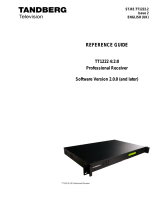 TANDBERG TT-1222 Reference guide
TANDBERG TT-1222 Reference guide
-
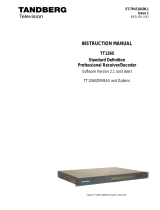 TANDBERG TT1260 User manual
TANDBERG TT1260 User manual
-
 TANDBERG CSR820 Operating instructions
TANDBERG CSR820 Operating instructions
-
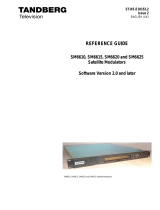 TANDBERG SM6610 Reference guide
TANDBERG SM6610 Reference guide
-
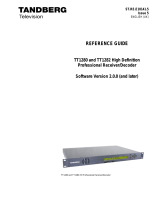 TANDBERG TT1282 User manual
TANDBERG TT1282 User manual
-
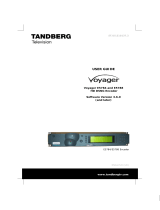 TANDBERG Voyager E5784 User manual
TANDBERG Voyager E5784 User manual
-
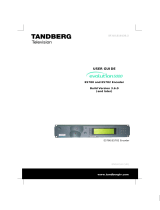 TANDBERG E5782 User manual
TANDBERG E5782 User manual
-
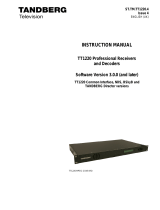 TANDBERG TT1220 Series User manual
TANDBERG TT1220 Series User manual
-
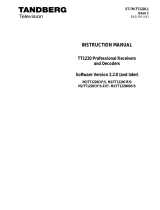 TANDBERG TT1220 Series User manual
TANDBERG TT1220 Series User manual
-
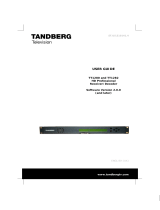 TANDBERG TT1282 User manual
TANDBERG TT1282 User manual
Other documents
-
Fracarro 283958 Datasheet
-
Promax MO-480, MO-481 Reference guide
-
Promax MO-480, MO-481 Reference guide
-
Motorola DSR-4440 Installation guide
-
Fracarro 280008 Datasheet
-
Thor HD-IRD-V3 User manual
-
Tektronix MTD200 User manual
-
Edision 563822 T.0X QUAD Modulator AV to COFDM/QAM User manual
-
SVP DR-100 Series User manual
-
PS Audio Power Director 3.5 User manual











































































































































































